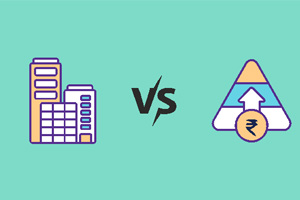Contrary to popular notion, bigger is not always better and sometimes the smallest things in life are all that matter. When it comes to investing, you may often be lured by bigger numbers. However, while large-cap funds may offer a seemingly bigger advantage of stability, mid-cap funds can offer their own share of advantages with potentially better growth. To find the winner between large cap vs mid cap, it is essential to delve deeper into their differences and characteristics.
What is a large-cap fund?
A large-cap fund is a mutual fund scheme that primarily invests in companies with large market capitalisations. Market capitalisation refers to the total value of a company's outstanding shares. According to the Securities and Exchange Board of India (SEBI), companies ranked from 1st to 100th in terms of total market capitalisation are called large-cap companies.
Large-cap companies are typically well-established, financially stable, and have a history of generating consistent profits. These companies are often considered leaders in their industries and are generally recognised names in the market.
What is a mid-cap fund?
A mid-cap fund is a mutual fund scheme that invests in companies with medium market capitalisations. According to the SEBI categorisation, companies ranked from 101st to 250th in terms of full market capitalisation are called mid-cap companies.
Mid-cap companies are generally smaller than large-cap companies but bigger than small-cap companies. They have the potential for higher growth and have more room for expansion than large-cap companies. They are not yet the biggest players in their field but have the scope to become the best.
Difference between large cap funds and mid cap funds
Here are some prime differences between large cap and mid cap funds:
Points of difference | Large cap funds | Mid cap funds |
Invests in | Top 100 companies in terms of total market capitalisation | Companies ranked from 101 to 250 in terms of total market capitalisation |
Fund composition | A minimum investment of 80% in equity and equity-related instruments of large cap companies | A minimum investment of 65% in equity and equity-related instruments of mid cap companies |
Risk | Relatively low, as large cap companies are more stable in the face of market volatility | Relatively high, as mid cap companies are somewhat less stable in the face of market volatility |
Investor profile | Suitable for investors with a low-risk appetite looking to invest in equity funds.
| Suitable for investors with a moderate to high risk appetite looking to invest in equity funds.
|
Which is better for investment - large cap funds or mid cap funds?
Large-cap funds are generally considered more suitable and may be ideal for conservative investors. If you want to prioritise stability over gains and are willing to accept relatively lower potential returns, large-cap funds may be ideal for you.
Mid-cap funds, on the other hand, can carry high risk and are better suited for investors with a higher risk appetite. These funds can offer you the potential for higher growth, but they also come with increased volatility and risk.
Both funds have their pros and cons. It is important to take a look at your risk appetite, financial goals, and time horizon before making a decision.
Conclusion
It can be confusing to choose between the two. However, it may be beneficial to diversify your investment portfolio and consider a combination of large-cap and mid-cap funds based on your individual financial goals and risk tolerance.
An investor education initiative by Edelweiss Mutual Fund
All Mutual Fund Investors have to go through a one-time KYC process. Investors should deal only with
Registered Mutual Fund (RMF). For more info on KYC, RMF and procedure to lodge/redress any complaints, visit - https://www.edelweissmf.com/kyc-norms
MUTUAL FUND INVESTMENTS ARE SUBJECT TO MARKET RISKS. READ ALL SCHEME-RELATED DOCUMENTS CAREFULLY
Trending Articles
MUTUAL FUND INVESTMENTS ARE SUBJECT TO MARKET RISKS, READ ALL SCHEME RELATED DOCUMENTS CAREFULLY.




















